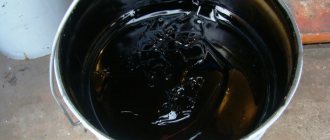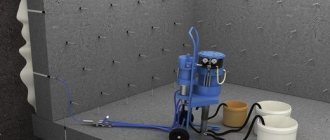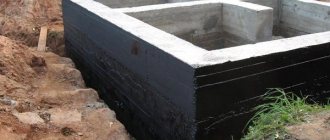During its entire “life”, the foundation is exposed to rain, groundwater and capillary water. The article will tell you what methods there are to waterproof a foundation with your own hands and what requirements must be placed on them.
Features and purpose
Due to the fact that the coating insulation is applied in a liquid state to the surface to be treated, all pores of the coated material, cracks and other damage are sealed, and the surface is covered with a monolithic protective film.
The film has sufficient elasticity that allows it not to collapse during seasonal temperature fluctuations; in its physical characteristics it is close to rubber.
Coating insulation is used in the construction of:
- foundations of various types;
- building plinths and their treatment both inside and outside;
- floors and walls of basements;
- any surfaces in contact with the ground;
- assemblies of door and window openings;
- pools and roofs.
Work related to the installation of waterproofing is regulated by the Code of Rules “SP 28.13330.2012 Protection of building structures from corrosion. Updated edition of SNiP 2.03.11-85 (with Amendments No. 1, 2).”
How does moisture affect the foundation?
There are several ways in which water leads to the destruction of a concrete foundation. Oddly enough, concrete is a material that can withstand multi-ton loads. But, unfortunately, not a single stone can withstand prolonged exposure to water. How exposure to water leads to destruction:
- Particles are washed out of the structure, and unevenness and potholes begin to form due to the chemical composition of groundwater or rainwater. It should be noted that rainwater can contain a large amount of impurities that have a detrimental effect on concrete.
- Water penetrates into the body of the foundation and freezes at subzero temperatures, causing the concrete to collapse. Water is the only substance in nature that expands when it freezes; its volume does not decrease. As soon as the liquid enters the capillaries, it affects the material from the inside, cracks and crevices begin to form.
For these reasons, vertical waterproofing of a strip foundation, as well as a columnar foundation, is very important.
Pros and cons of coating waterproofing
The advantages and disadvantages of this type of waterproofing are determined by the physical properties of the materials used and the technology for their implementation.
The advantages of coating waterproofing are:
- Low cost.
- High adhesion rates (ensuring contact between the surface and the material used).
- Ease of work (application to the surface to be treated).
There are a few more disadvantages, these are:
- when applied to the surface to be coated, it requires careful preparation (cleaning from dust and dirt, sealing cracks and other damage);
- work must be carried out at positive ambient temperatures and in the absence of precipitation (for external work);
- limited service life (5 – 6 years);
- when using bitumen and bitumen-containing mastics, they need to be heated, which increases labor costs for performing such work, and the use of open fire is a potentially fire hazardous event;
- When the surface treated with coating insulation is deformed, as well as other external influences, the waterproofing layer peels off.
How to make a blind area
Is it necessary to do vertical waterproofing of the foundation if there is a blind area around the house? Of course, it is necessary, since the blind area itself will not be able to completely protect the foundation of the house from moisture completely. In order to make reliable and durable protection, you will need to move in three directions - install vertical and horizontal insulation, as well as a blind area around the foundation.
When carrying out waterproofing work on the foundation, the following materials are used to make the blind area:
- Asphalt concrete.
- Concrete.
- Paving slabs.
- Clay.
- Diffusion membrane.
The method of making the blind area will directly depend on the preferences of the home owner, as well as on the architectural features. And most importantly, it depends on the availability of the materials used. The cheapest option for making a blind area would be to lay it out of asphalt or concrete.
It is worth noting that such a blind area is not attractive, but it can protect the foundation of a structure without a large investment of labor and money. You can really save a significant amount on materials. It should also be noted that blind areas made of asphalt or concrete are very popular in the mass construction of apartment buildings, as well as public and administrative buildings.
Materials for coating waterproofing
To install coating waterproofing of foundations, special bitumen-based mastics, bitumen, cement-based compositions, and polymer materials are used.
Materials containing bitumen
In this group of waterproofing materials, bitumen comes first, but since... When using it, it requires heating, then due to the advent of new materials, its use is reduced.
Solid bitumen will need to be heated before application.
Various plasticizers (rubber, silicone) and sealants are added to the composition of bitumen-based mastics, which improves their physical properties, performance characteristics, as well as the conditions for performing work using them. Bitumen-polymer mastics do not require preheating, but before applying them it is necessary to treat the surface to be coated with a special composition - a primer primer.

Primer for bitumen mastic
Primer - primer is applied to improve adhesion, strengthen the treated base and close pores on its surface. Primer primers are manufactured on mineral, bitumen, alkyd and acrylic bases and for various types of bases (concrete, brick, wood, etc.).
Mastics are produced as one-component ones, which can be used without additional preparation, and two-component ones, which require preparation for use.
For different types of bases, different brands of mastics are produced: for foundations and floors, under tiles, for roofing, as well as for parts of buildings and structures in contact with the ground.

Bituminous mastic that does not require heating
Cement based materials
Cement-polymer mastics include Portland cement, mineral fillers and polymerizing additives. These are two-component formulations, the preparation of which requires water or a special emulsion.
In addition, the industry produces mixtures that, in addition to cement, contain resins and inert fillers, as well as organic additives.
These materials are somewhat more expensive than those made on the basis of bitumen, but due to the fact that when performing work using them, the total volume of construction and installation work is reduced, the total cost of construction is almost identical for both options.
The reduction in the amount of work is due to the fact that the cement-based waterproofing layer also serves as a screed for the final coating of the treated surface.
Polymer materials
This group of waterproofing materials includes mastics made from synthetic emulsions, rubber, plasticizers and other technological additives.
Polymer mastics are much more expensive than materials based on cement and bitumen, but due to their technological performance, which is significantly superior to these materials, they are becoming increasingly widespread.
The advantages of polymer materials are:
- High adhesion to the surface to be coated.
- Elasticity.
- Absolutely waterproof.
- Fire safety.
How to protect a foundation slab
There is another type of foundation, which is one of the most common - it is slab. And the methods of waterproofing this base are slightly different from those that can be found on a tape base. In order to protect the foundation slab from moisture, you need to take the following measures:
- Carry out concrete preparation in order to protect the slab from groundwater, as well as level the base.
- Install waterproofing over concrete preparation.
- Protect the structure from external moisture.
In order to make the second layer when arranging the slab, it is necessary to use rolled materials. Experts recommend using modern materials, since after the slab has been poured, it is almost impossible to repair and monitor the condition of such an insulating material.
For small buildings (subject to low water saturation of the soil), polyethylene film can be used. It can also be used in the construction of structures that are not of particular importance (for example, cabins, sheds, sheds for basements, garages). In order to protect the slab from moisture, it is necessary to use penetrating compounds. You can find a fairly simple method during construction - a solution of waterproofing material is introduced into concrete. After pouring the slab, it is imperative to lay the rolled material in the places where the walls will be located.
Service life and technical characteristics
Each type and type of material used to perform coating waterproofing is characterized by certain technical characteristics that determine its use and purpose, as well as service life that is guaranteed to meet the requirements for them.
Bitumen-based materials
Characteristics of bitumen mastics:
- coating layer thickness – 4.0 – 5.0 mm;
- conditional strength – 0.2-0.5 MPa (kgf/cm2);
- adhesion strength to the base (concrete) – 0.3-0.4 MPa (kgf/cm2);
- water absorption (by weight) – no more than 0.5-1% during the day;
- ability to elongate at break – 100-300%;
- conditional viscosity – at least 15-30 seconds;
- softening temperature – more than 100°C.
- service life – 4.5 – 6 years.
Cement based materials
Characteristics of cement-polymer mastics:
- coating layer thickness – 2.0 – 4.0 mm;
- conditional strength – 5.0-60.0 MPa (kgf/cm2);
- adhesion strength to the base (concrete) – 1.3-2.5 MPa (kgf/cm2);
- water absorption (by weight) – 0.1-8.0% during the day;
- brittleness temperature – minus 20*C;
- Service life – 5 – 8 years.
Polymer materials
Characteristics of polymer mastics:
- coating layer thickness – 1.0 – 2.0 mm;
- adhesion strength to the base (concrete) – 0.7-0.8 MPa (kgf/cm2);
- ability to elongate at break – 100-300%;
- operating temperature – from – 30 to + 60°С;
- application temperature – from 5.0 – 30.0 *C;
- service life – 8 – 15 years.
Coating waterproofing technology
Work on installation of coating waterproofing is carried out as follows:
- The foundation surface is being prepared for waterproofing work. Dirt, dust and foreign objects are removed. Sharp edges and protrusions are rounded, metal embedded parts are cleaned of corrosion, cracks and seams are puttied.
- The surface is treated with a primer primer, and the type of primer must correspond to the type of waterproofing material. For mastics made using organic solvents, primers with a similar solvent are used, and similarly for water-based compositions. Primer primers are applied to the surface using hand-held painting tools (brushes, rollers).
- After this, when using bitumen and bitumen-polymer mastics, bitumen varnish is applied, which will improve adhesion when applying the first layer of mastic to the base to be coated. The varnish is applied with a hand painting tool or using a spray gun, after which time is given to dry.
- While the varnish dries, the mastic is prepared. If these are bitumen-based mastics that require heating, then they are heated, and two-component ones are mixed in accordance with the instructions for their use.
- The first layer of mastic is applied, using either a hand-held painting tool or spatulas, depending on the consistency of the material. The corners are carefully coated.
- Mastics are laid in an even layer over the surface of the foundation. Time is given for the laid layer to harden. After the first layer of mastic has hardened, the subsequent ones (two, three) are laid in a similar sequence.
- To give strength to the waterproofing, it is reinforced. To do this, after applying the first layer, a layer of fiberglass or fiberglass is glued, which will ensure the safety of the waterproofing layer during seasonal deformation of the foundation.
- Bitumen, as a rule, is used when installing horizontal waterproofing when it is necessary to install a thick waterproofing layer. It is applied using wooden spatulas and leveled with stiff bristled brushes.

Coating waterproofing can act as an independent type of foundation treatment, serving to protect against moisture penetration, and also as an additional one when installing adhesive-type waterproofing.
Types of moisture protection by location
In general, three types of waterproofing work can be distinguished:
- Vertical.
- Horizontal.
- The blind area is one of the types of hydraulic barriers.
Depending on what type of base is used, one or several waterproofing options can be used. It is worth noting that it is necessary to strictly follow the technological map for vertical and horizontal waterproofing of the foundation. In this case, you will be able to increase the maximum insulation resource.

Horizontal is necessary in order to prevent water from penetrating between different levels of the structure. Waterproofing is carried out using various materials and can be mounted on any foundation - strip, slab, pile, columnar. Of course, the method of laying the material will be slightly different.
Vertical waterproofing of the foundation with roll materials is carried out in the same way as with coating materials. It is necessary to prevent groundwater from entering the foundation structure. In this case, water will not be able to affect the concrete. But it should be noted that vertical waterproofing is not done for all types of foundations. It is needed only for columnar supports of the structure and strip ones. As for horizontal protection, it is mandatory when constructing all types of foundations.
With the help of a blind area, it is possible to protect the base from melt and rain water. The most important thing when installing a blind area is to choose its width correctly, since if you make it too small, the moisture will be drained over a short distance and will easily reach the base. Such protection will remove a significant part of the load from the remaining waterproofing layers, therefore, the service life of the latter will increase.











